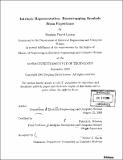| dc.contributor.advisor | Patrick H. Winston. | en_US |
| dc.contributor.author | Larson, Stephen David, 1980- | en_US |
| dc.contributor.other | Massachusetts Institute of Technology. Dept. of Electrical Engineering and Computer Science. | en_US |
| dc.date.accessioned | 2005-09-26T20:35:47Z | |
| dc.date.available | 2005-09-26T20:35:47Z | |
| dc.date.copyright | 2003 | en_US |
| dc.date.issued | 2003 | en_US |
| dc.identifier.uri | http://hdl.handle.net/1721.1/28462 | |
| dc.description | Thesis (M. Eng.)--Massachusetts Institute of Technology, Dept. of Electrical Engineering and Computer Science, 2003. | en_US |
| dc.description | Includes bibliographical references (p. 95-96). | en_US |
| dc.description.abstract | If we are to understand human-level intelligence, we need to understand how meanings can be learned without explicit instruction. I take a step toward that understanding by focusing on the symbol-grounding problem, showing how symbols can emerge from a system that looks for regularity in the experiences of its visual and proprioceptive sensory systems. More specifically, my implemented system builds descriptions up from low-level perceptual information and, without supervision, discovers regularities in that information. Then, my system, with supervision, associates the regularity with symbolic tags. Experiments conducted with the implementation shows that it successfully learns symbols corresponding to blocks in a simple 2D blocks world, and learns to associate the position of its eye with the position of its arm. In the course of this work, I take a new perspective on how to design knowledge representations, one that grapples with the internal semantics of systems, and I propose a model of an adaptive knowledge representation scheme that is intrinsic to the model and not parasitic on meanings captured in some external system, such as the head of a human investigator. | en_US |
| dc.description.statementofresponsibility | by Stephen David Larson. | en_US |
| dc.format.extent | 96 p. | en_US |
| dc.format.extent | 5255563 bytes | |
| dc.format.extent | 5266485 bytes | |
| dc.format.mimetype | application/pdf | |
| dc.format.mimetype | application/pdf | |
| dc.language.iso | en_US | |
| dc.publisher | Massachusetts Institute of Technology | en_US |
| dc.rights | M.I.T. theses are protected by copyright. They may be viewed from this source for any purpose, but reproduction or distribution in any format is prohibited without written permission. See provided URL for inquiries about permission. | en_US |
| dc.rights.uri | http://dspace.mit.edu/handle/1721.1/7582 | |
| dc.subject | Electrical Engineering and Computer Science. | en_US |
| dc.title | Intrinsic representation : bootstrapping symbols from experience | en_US |
| dc.type | Thesis | en_US |
| dc.description.degree | M.Eng. | en_US |
| dc.contributor.department | Massachusetts Institute of Technology. Department of Electrical Engineering and Computer Science | |
| dc.identifier.oclc | 57124903 | en_US |
